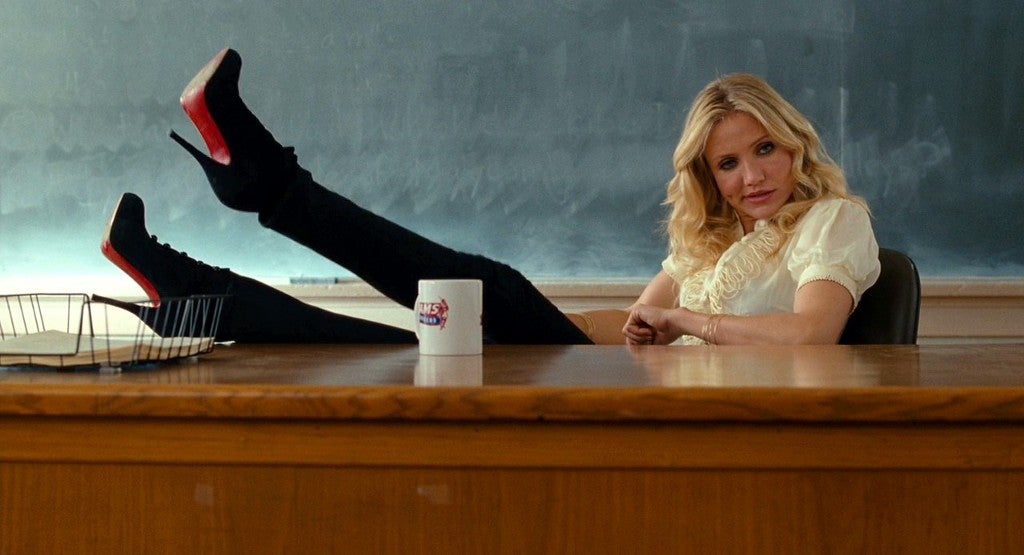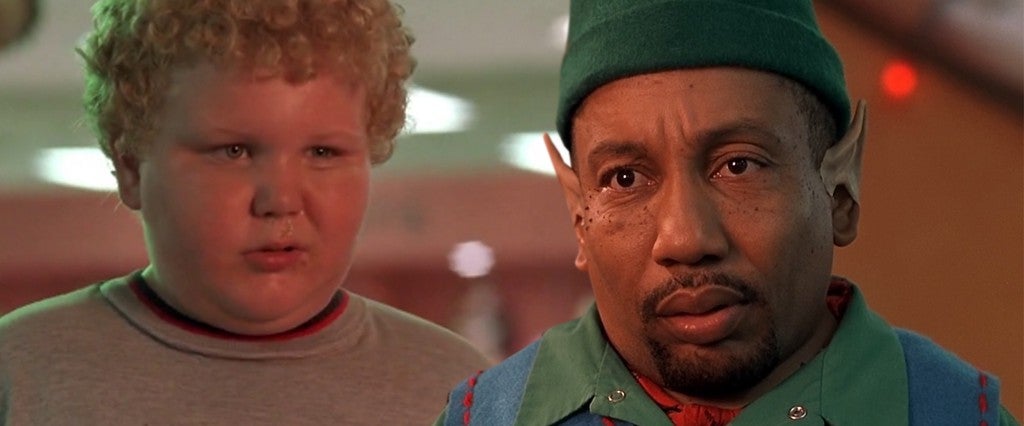I recently reviewed Bad Santa 2 — a painfully unfunny sequel to the 2003 cult classic. Several readers were disappointed — they loved the original, in which Billy Bob Thornton poses as a department store Santa to infiltrate malls and rob them blind. What I didn’t have the heart to tell these readers was that I never really liked the first film, either. What’s worse: I hate the “bad” genre that Bad Santa spawned.
When Bad Santa debuted around Thanksgiving 13 years ago, it was a bit of an underdog against that weekend’s bigger family films like The Cat in the Hat — and the much-loved, adorable blockbuster Elf, which had opened earlier in the month. By comparison to those feel-good flicks, Bad Santa was a raised middle finger, a pissy takedown of bogus Yuletide cheer that featured a callous, alcoholic horndog as its main character. This anti-holiday film hit back at the oppressive, saccharine groupthink about Christmas — it wanted to sweep away the stifling solemnity around a holiday that was really just an excuse for rank commercialism. Instead of a kind, wise old man with a white beard like we had in Miracle on 34th Street, Thornton’s fake-Santa was a crude, surly cynic whose foul-mouthed tirades punctured the bullshit sanctity of the season.
Bad Santa became a word-of-mouth hit, its liberating cut-the-crap candor speaking to viewers who never cottoned to the supposed specialness of Christmas. Suddenly, the “dark secret” held by so many people — I feel like a bad person because I’m the only one who hates Christmas — was suddenly let loose into the culture, helping to diminish the unpopular opinion’s stigma.
That emotion — the one that makes you feel unique because you actually hate Christmas and it feels so good to feel so bad — is what Bad Santa works with. But Bad Santa was just a fairly obvious black comedy whose main trait was how blatantly, repetitively awful its main characters were. Watching Thornton’s drunken Willie T. Stokes revel in anal sex and tell off bratty kids who sat on his lap, I didn’t feel any sense of liberation — nor did I think the movie expressed some needed-to-be-said deep truth. Bad Santa just seemed exhausting: tiresome bad behavior parading itself as wised-up insight. As L.A. Weekly’s Scott Foundas put it perfectly at the time, “Hearing Santa say ‘f — -’ isn’t nearly as funny the 50th time as it is the first 49.”
But Bad Santa looks like Citizen Kane in comparison to the films that have emerged in its wake. It’s typical that when a successful movie comes around, there will be copycats that are likely to miss the essence of what made the original so great, instead just duplicating its most basic elements. And so we’ve been gifted with movies like Bad Teacher, Bad Words, The Bronze (which was quickly nicknamed “Bad Gymnast”) and, most recently, Bad Moms. (You might include Horrible Bosses on this list, too, but I’d argue that film differs from the others in a crucial way: For it to be a proper “bad” comedy, the main character should be in a profession or milieu where we expect people to behave appropriately.)

The central joke to all these movies is the same: An absolute reprobate enters into a sweet, innocent world and takes a flamethrower to the place, reveling in his or her snotty irreverence. In Bad Teacher, that world is public school education. In Bad Words, it’s spelling bees. In The Bronze, it’s the Olympics in general and the gracefulness of gymnastics in specific. Bad Moms tweaks the formula somewhat, which is why it’s easily the most tolerable of the bunch: The central mom characters decide to let go of the idea of being perfect so that they’re no longer beholden to the unreasonable, sexist demands that society places on them. But the idea in all these “bad” comedies is that some beloved or hallowed institution is overdue for a good scorning.
And what’s the best way of sticking it to these sacred cows? Through rampant vulgarity, of course. There’s a proud tradition of smart, crude comedy that extends from Mel Brooks to Zucker/Abrahams/Zucker movies like Airplane! But those filmmakers’ anarchy was built around a giddy love for juvenile silliness — you felt a joy in their coarseness. (Even dyspeptic TV shows like Seinfeld, Curb Your Enthusiasm and It’s Always Sunny in Philadelphia acknowledged that their characters’ meanness was a dead end — we mocked their sullenness.) But since Bad Santa, there’s been an increasing emphasis on characters who simply do terrible things with the dull precision of someone checking off items from a misanthropist’s to-do list. Ridiculing the less intelligent? Check. Having “crazy” sex to scandalize any prudes in the audience? Check. Sabotaging innocent victims in public so you can get ahead? Check. Never mind that the targets of these attacks did nothing to deserve being humiliated — we’re just supposed to enjoy watching nice people get blown up.
These movies want us to know that it’s totally okay that their main characters are complete assholes. You see, they’re just damaged individuals who, deep down, will become good people once they come in contact with someone who’s kind and helps them change their ways. This conceit, again, originated in Bad Santa, where Thornton’s grumpy thief (who had a cruel upbringing) gains a conscience after hanging out with a social pariah (Brett Kelly) who teaches him compassion. Ultimately, the bitter Willie gets his happy ending and discovers the spirit of Christmas — a sort of modern riff on A Christmas Carol in which our Scrooge gets his own temperament makeover.
To be charitable, this forgiving of unacceptable conduct could be seen as optimistic, saluting the belief that even the most wretched of souls can find redemption. But it’s also utterly bogus — and, ironically, it’s a notion that Bad Santa’s director actively fought against. In a 2012 interview, Terry Zwigoff — who had previously directed the prickly Crumb and Ghost World — lamented, “The studio wanted to mess with [the movie] and make it more mainstream and pour some fake sentiment on it for the people that stumble around the mall. Go to Target some day and look at who your target audience is. Look at the people who are out there going to films, and you realize you are totally fucked, you don’t want to do anything these people like.”
That, my friends, is a true-blue curmudgeon — a guy who doesn’t believe in easy changes-of-heart and has the courage of his snarling convictions. But the studio won, and as a result the cookie-cutter process by which most “bad” movies are now made caters to the mainstream crowd that Zwigoff clearly despised. These horrible characters can be terrible — just as long as they shape up by the end. It’s gutless, essentially indulging the audience’s hidden desire to behave badly but then pleasantly reassuring us that, don’t worry, we’re actually all perfectly decent people. The implication is that all our bad behavior is just one nice gesture away from being redeemed — that nobody is actually wicked and that extenuating circumstances should mitigate any actual wretchedness.
When Zwigoff made Bad Santa, it came from a place of wanting to continue pursuing films that, according to the director, were “about outsiders and misfits and underdogs and generally unsympathetic characters whom I find sympathetic, or at least drive to make sympathetic. But I try to have them play it honestly and truthfully.” In the 13 years since that movie, though, the honesty and truthfulness have been completely drained out of the template. Instead, these comedies celebrate a bullshit version of sanitized badness that’s actually afraid to consider the dark, ugly rottenness inside their characters — and, by extension, that same rottenness in all of us.
Terrible things happen in the real world all the time — murder and war and sexual abuse and other monstrosities — and we always wonder how people could be capable of such horrible deeds. But the wave of “bad” movies (which continues with Bad Santa 2 — have no fear, it has a happy ending, too) underlines a fascinating paradox in our society. We like to pretend that we’re enamored with bad behavior but, really, we just enjoy play-acting. We want to live vicariously through these characters’ relatively minor transgressions and then return to our safe lives, comfortable in the knowledge that they learned their lesson and are now good. But here’s the thing about truly awful people: They don’t want to be redeemed, because they don’t believe they need to be. By comparison, the “reality” these asinine “bad” comedies are peddling is just another Hollywood fantasy. It’s a bizarro land in which a character with a potty mouth is somehow considered deeply subversive — but true evil is a thing we’d prefer ignoring.

